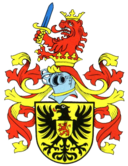
 47°46' N 9°10' E, 377.5 miles SSW of Berlin. Überlingen is a city on the northern shore of Lake Constance. After the city of Friedrichshafen, it is the second largest city in the Lake District and a center for the outlying communities. The healing mineral water from a source under one of the towers on the western side of the city wall was known since the early 16th century, and produced a regular source of income for the city but during the Thirty Years War the spring was vered over and remained covered until a spa hotel was constructed and notables started to arrive in the early 1800s .Economic problems were in large part due to transportation difficulties . Although the first coal powered steam ship, the Hohentwiel. traversed the Lake in 1825, it was not until 1895, with the construction of a railway link to Überlingen, that the city emerged from economic difficulties as a spa city. In 1901, the link was connected through Friedrichshafen, making travel to and from the city easier and improving the city's prospects as a spa. Once the rail line was completed, it became feasible as a spa resort. Wikiopedia. [Apr 2013]
47°46' N 9°10' E, 377.5 miles SSW of Berlin. Überlingen is a city on the northern shore of Lake Constance. After the city of Friedrichshafen, it is the second largest city in the Lake District and a center for the outlying communities. The healing mineral water from a source under one of the towers on the western side of the city wall was known since the early 16th century, and produced a regular source of income for the city but during the Thirty Years War the spring was vered over and remained covered until a spa hotel was constructed and notables started to arrive in the early 1800s .Economic problems were in large part due to transportation difficulties . Although the first coal powered steam ship, the Hohentwiel. traversed the Lake in 1825, it was not until 1895, with the construction of a railway link to Überlingen, that the city emerged from economic difficulties as a spa city. In 1901, the link was connected through Friedrichshafen, making travel to and from the city easier and improving the city's prospects as a spa. Once the rail line was completed, it became feasible as a spa resort. Wikiopedia. [Apr 2013]
CEMETERY:
History and photos. [Apr 2013]
a.S.: 88662 Baden-Wuerttemberg
Zur Geschichte der Juden in Ueberlingen a.S. in: Zeitschrift für ide Geschichte des Oberrheins. N. F. 28-67 (1913,) S. 353-369. Source: Angelika Ellmann-Krüger
Christian Cemetery: In the Überlinger cemetery, opposite the cemetery chapel, in the second row, is a Jewish grav stone with the Hebrew inscription: "Here lie the bones of unknown Jewish people. They were buried in the Jewish cemetery in 1349." How did Jewish bones come to a Christian cemetery? And why is a new gravestone dedicated to people who died 650 years ago? Once, there actually was a Jewish cemetery in Überlingen somewhere else other than the Municipal Cemetery: The Jewish cemetery was between the Obertorstraße and Frohsinnstraße.and the gravestone moved. In the 14th century, the Jewish cemetery was closed. "The gravestones of the Jews were used in construction of public buildings while the remains of the deceased remained in the earth," says the historian Oswald Überlinger Burger. In construction of the cathedral begun at this time, the Jewish gravestones were used as building materials. "Theologically quite reasonable: the Christian church stands on a Jewish foundation," Burger said with a grin. Around 1900, during restoration of the cathedral, fragments of several Jewish gravestones were removed and stored at the museum until 1990 when they were placed in the garden. "For a long time only the approximatel location was known," says Oswald Burger..."... in 2006 in heating installation in a building a road, the builders found human bones. The police investigated as murder, but quickly realized that it was the 14th century bones. The Jewish cemetery was found. "We discovered the remains of four Jewish people. If you were to dig in this area, you would find hundreds, "says Burger. The bones were stored for several years on the Überlinger cemetery until in 2008 a gravestone was made by sculptor Ricardo Itta. "The gravestone is inspired precisely by the Jewish gravestones in the museum garden" Oswald says Burger. Even the Hebrew inscription is not sharp, as usual on Christian grave stones, but - typically Jewish - flat carved into the stone. The bones were buried in the Überlinger cemetery. And on the gravestone are numerous small stones. "This is typical of Jewish graves," says Oswald Burger."This comes from the days of the desert burials, when the Jews covered their dead with stones for protection from wild animals. "Once he had shown the gravestone to visitors, questioning whether the bones should have been buried here at all. "For Jewish bones may not be exhumed," says Burger. They had not known; and the Jewish High Council, the City informed at that time, had not returned. Now the exhumation has been done long ago and the Jewish people linger ... rest in peace - in the midst of their Christian fellow citizens. A beautiful symbol of the now-long peace between the two peoples." photo and story in German. [Mar 2013]
